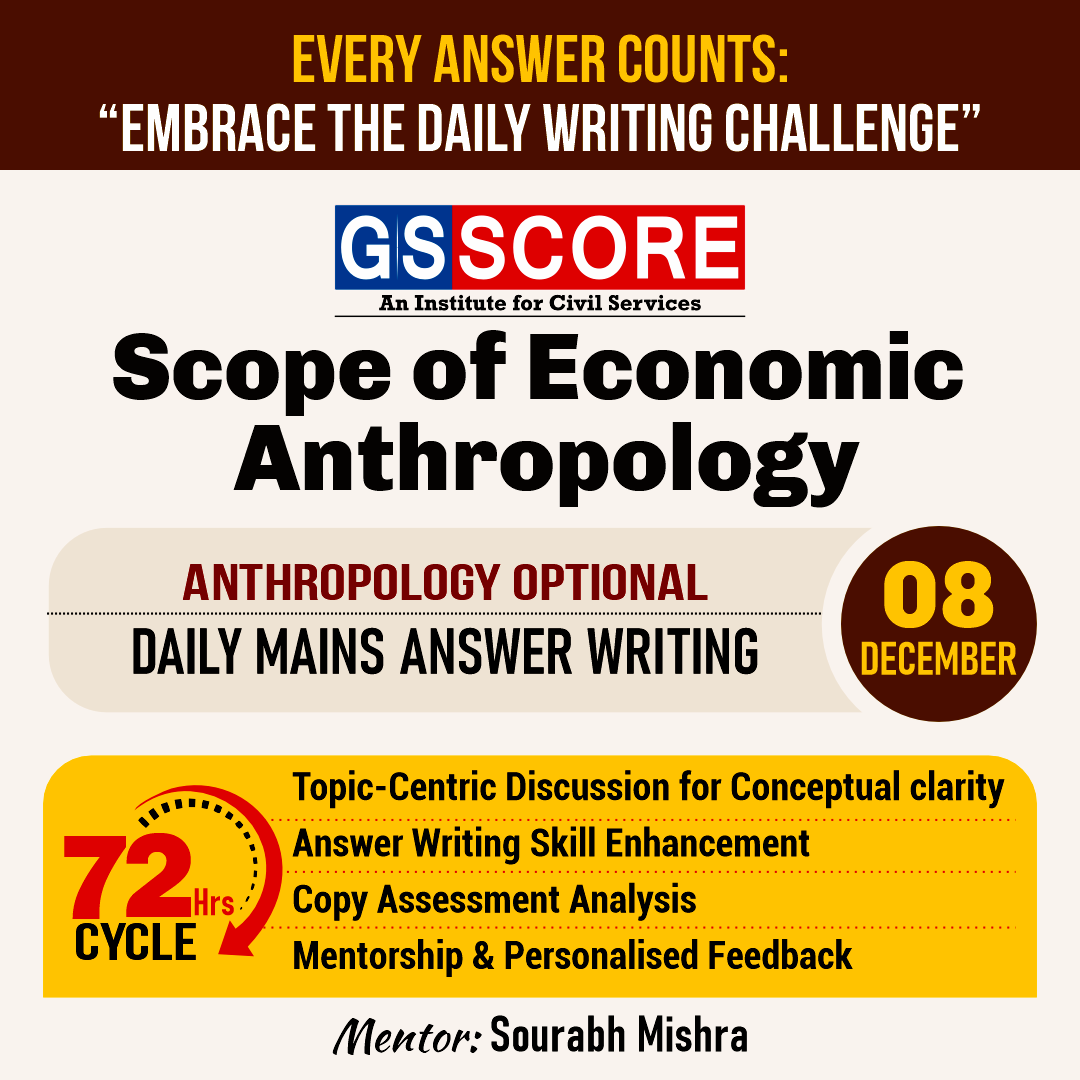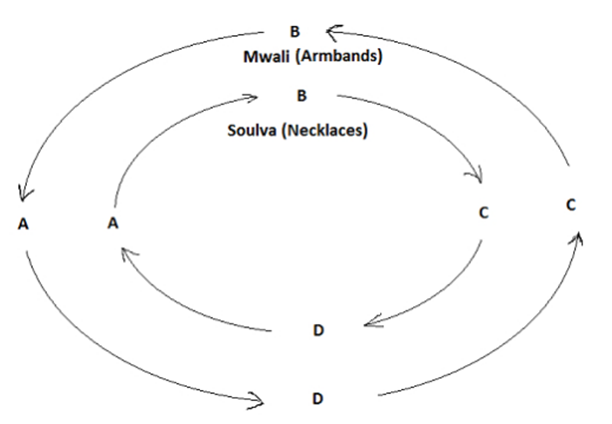


Instruction:
- There will be 2 questions carrying the First Question is-10 marks Write your answers in 150 words and the Second Question is-15 marks Write your answers in 250 words.
- Any page left blank in the answer-book must be crossed out clearly.
- Evaluated Copy will be re-uploaded on the same thread after 2 days of uploading the copy.
- Discussion of the question and one to one answer improvement session of evaluated copies will be conducted through Google Meet with concerned faculty. You will be informed via mail or SMS for the discussion.
Question #1. Explain how primitive economy is inclined towards substantivism as opposed to formalism. 10 marks (150 words)
Question #2. What is the scope of Economic Anthropology? Explain various forms of exchange system. 15 marks (250 words)
(Examiner will pay special attention to the candidate's grasp of his/her material, its relevance to the subject chosen, and to his/ her ability to think constructively and to present his/her ideas concisely, logically and effectively).
STEPS & INSTRUCTIONS for uploading the answers
Step 1 - The Question for the day is provided below these instructions. It will be available at 7:00 AM.
Step 2 - Uploading of Answers : Write the answer in A4 Sheet leaving proper margins for comments and feedback and upload the PDF in MY ACCOUNT section. Click on the option of SUBMIT COPY to upload the PDF.
Step 3 - Deadline for Uploading Answers: The students shall upload their answers by 7:00 PM in the evening same day. The first 50 copies will be evaluated.
Step 4 - Feedback : Mentors will give their feedback for the answers uploaded. For more personalised feedback, join our telegram channel by clicking on the link https://t.me/mains_answer_writing_cse . A one-to-one session will be conducted with the faculty after copy evaluation in 72 Hrs.
Model Answer
Question #1. Explain how primitive economy is inclined towards substantivism as opposed to formalism. 10 marks (150 words)
Approach:
- Introduce by briefly explaining both the schools of thought and what they seek to analyze.
- Body should include explanations of both the schools with examples.
- Conclusion.
Hints:
Economic anthropology deals with the economic aspect of societies in socio-cultural context. There are two views in the school of economic anthropology such as formalism and substantivism. Also, new school Neo-Marxism came into being which considers earlier two schools to be inappropriate and they explained the economic behavior of tribal societies through the prism of Marxism.
The opposition which exists between formalist and substantivist school was 1st proposed by Karl Polanyi in his book-”the Great transformation” (1944) in which he argued that ‘Economics’ has two meanings formalist and subtantivism
Formalist approach
This school was advocate by Raymond firth, Salisbury, Schneider, Herskovits and et al. they advocated that economic structure of simple societies can be studied through the principles of modern economics like
- Money- as a standardized system of exchange by which every economic activity can be reduced to exchange of money.
- Market- all the exchanges take place through market principle and every individual enters the market with principle and economic rationality.
III. Profit maximization- all individuals are buyers and sellers thus they all are full time specialists.
- Market rationality- economic relations are based on market rationality. It means decision making based on cost benefit relationships.
- Division of labor is clear.
- Follows principle of demand and supply and product maximization.
VII. Structure of society is stratified.
VIII. Unit of production: - individual.
- Type of economy: Actor oriented economy
Criticism:
- Its central assumptions about human behavior have been questioned. In particular, it has been argued that the universality of rational choice and utility maximization cannot be assumed across all cultures.
- Narrow focus i.e. atomized individual behavior to exclusion of socio-cultural context.
Substantivist approach:
This approach was advocated by Dalton, Polanyi, and sahine. They argued that the economy of simple society is not pure economy but social economy i.e. underlying principles of economy are social. They have observed that economic activity in simple society is integrated with other socio- cultural life. It is basically a close relation between economy and culture.
Characteristics:
- Type of economy- system oriented economy.
- Principle of maximization- production optimizers.
- Unit of production- Group.
- Target of production is to not gain surplus but to fulfill the needs of community at optimum level.
- Principle of rationalization- economic decision making based on social relationships and cultural values.
- Exchange- reciprocity is there.
- Division of labor- minimal.
- Fulfilling the needs of society is more important than demand and supply.
- Structure of society- egalitarian.
- Kinship based economy.
Example:
Kula: it is a typical feature of many island people of western pacific, can be defined as a system of exchange supported by a complete set of rituals and dominated by values and ideologues.
All steps in the Kula, explained by Malinowski, social roles score over economic roles. As the meagre quantitative aspect of economic exchanges through hazardous, modern economist tends to see as an uneconomic activity but it has deep social value as voyages for Kula and subsequent meetings strengthened the social bonding between the islanders generating the social current that increases their survival.
Criticism:
- Prattis (1982) argues that strict distinction between primitive and modern economies in substantivism is problematic.
- Plattner (1989) argues that some generalization between western and non-western economies are still possible as there are hardly any pure pre industrialized societies left.
Conclusion:
Thus in today’s modern capitalist economies substantivism and formalism coincide. Market exchange is seen as the dominant mode of integration while reciprocity may continue inside the family and some redistribution may be undertaken by state/charitable institutions.
However, debate is outdated in the sense today we do not compare different discipline but follow inter-disciplinary approach try to bring them for mutual benefit.
Question #2. What is the scope of Economic Anthropology? Explain various forms of exchange system. 15 marks (250 words)
Approach:
- Introduce with meaning of economic anthropology and why it is important
- Thinkers perspective on economic anthropology
- Discuss in detail the meaning and scope of anthropology
- Various forms of exchange system with examples
- Conclusion
Hints:
Economic anthropology can be defined as the cross cultural and comparative study of economic system of various societies. It is different from the subject of modern economy. Although it studies all kinds of economic systems, however it focuses on simple economy. The contemporary trends in economic anthropology are centred on changes in economic behaviour as a part of culture. It has many social-cultural utilities.
Thinker’s perspective:
Firth: economic anthropology deals primarily with “the economic aspects of social relatives”
Nush: economic anthropology analyses “economic life as a sub-system of society”
Beals and hoijer: economic anthropology studies “the distribution and consumption as these, are institutionalized or formalized in socio-cultural subsystems”.
Plattener: economic anthropology studies economic behaviour as thoroughly embedded in socio- cultural aspects.
Meaning of economic anthropology and modern economics:
Economics as a subject is concerned with individualized societies. It mainly deals with demand- supply principles and price mechanism, capital market or stock market, financial and labour management and also fiscal management. It does not study economic activity in relation to other institutions of society i.e. (marriage, family, kinship etc.). Thus it is a part study.
Whereas economic anthropology studies economic aspects of a society in relation to its culture, the kinship system, political organization, value system etc. for e.g. potlatch in which wealth is destroyed to elevate social status. The custom is prevalent in many societies. Thus this kind of economic behaviour cannot be explained by modern economics. To understand this type of behaviour, an integrative approach must be adopted. Thus economic anthropology studies the economic system as an integral part of the cultural matrix.
It also emphasizes comparison of a simple economic system to that of other cultures to bring about certain generalizations about economic behaviour across the world. Thus economic anthropology studies the economic behaviour of man in a holistic manner or in totality, which is the fundamental principle in economic anthropology.
The scope of Economic Anthropology
During its formative period, its scope was restricted to the study of economic life of the primitives.
The major debates in economic anthropology have centred on
(a) The universal applicability of Western generated categories of analysis,
(b) The question of value,
(c) The question of history and connectedness between polities, and
(d) The weight of culture (meaning) in economic processes.
Different types of exchange in economic anthropology:
Most of what is produced by human labour is distributed by means of exchange. Exchange refers to the pattern of giving and receiving valuable objects and services. Human beings cannot live without exchanging their labour or the products of their labour with one another. The pattern of exchange varies from one society to another. Following Karl Polanyi, we will distinguish three modes of exchange- reciprocal, redistribution and market. Although all three may operate as component aspects of a single economic system, it is usual for one or another of them to be dominant in structuring the process by which most consumer goods and services are moved within a particular society.
Types:
- Ceremonial exchange or kula exchange
- Reciprocity
- Redistribution
- Barter
- Market
Ceremonial or kula exchange
In Melanesia, some islands have a food surplus but shortages of tools, some other Islands have surplus tools but shortages of food. No Island has the skills to produce all the goods to be consumed. Under these circumstances, One Island depends upon another Island to get the required items. This created the Kula exchange.
The exchange of shell ornaments with their trade partners were made in the Kula trade. The ornaments, known to the Trobrianders as vaygu’a, consist of armbands and necklaces.
Two kinds of ornaments are involved in the ceremony of exchange white shell armbands, known as “Mwali” which travel around the circle of Islands in a counter clockwise direction, and red shell necklaces known as “Soulva” which travel around the Islands in a clockwise direction. As each of these article travel around the Islands, it meets and is exchanged for an article of the other type. Every detail of the tradition is fixed by tradition. In every village, on the participating Islands, some of the men take part in the Kula. These men receive the necklaces or bracelets from their trading partners, hold them for a while and then pass them on. No man keeps any article in his possession permanently. The partnership is often maintained for years. A commoner may have five or six such relationships, but a chief may have as many as seventy.
When the leaders are exchanging ceremonial goods, their fellowmen will be engaged in barter activities. They exchange their goods for the goods of others. In this context, considerable bargains go on.
Thus, the Kula system serves the following functions-
- Indicates status of individuals who are parties to the transaction.
- Creates a peaceful atmosphere for affecting the barter system.
- Provides congenial atmosphere for renewal of friendship and for creation of new partners.
- Keeps the partners in everlasting obligations of reciprocity and exchange of maternal goods.
Reciprocity
It is a mode of economic distribution in which resources are presented by one individual or one group to another individual or group with the expectation on both sides that sooner or later the second will return something of approximately the same value to the first. More plainly, it refers to the giving and taking between people who are bound by social ties and obligations. It ranges from gift-giving to equalized barter and self-interested cheating (although in the latter reciprocity is not involved). Reciprocity is crucial in primitive societies; it plays a fundamental part in hunting-gathering, horticultural and pastoral societies. Marshall Sahlins distinguished three subtypes of reciprocity-
Generalized Reciprocity:
- This is gift-giving without an immediate or planned return.
- No accounts are kept.
- It usually takes place between kin or close friends, but it is typical of the family, where parents feed and take care of their children with no calculation of expected return, although presumably one or more of their children will feed them and take care of them when they are old.
- Gift-giving is not altruism, but an affirmation of the importance of interdependence.
- People remember their gift-giving activities and if they were not reciprocated they would express strong disapproval.
- Generalized reciprocity does not collapse when resources become scarce, rather the opposite happens. However, under extreme scarcity (famine), the gift-giving system may breakdown or be limited to the household.
Balanced Reciprocity:
- Here, the partners are linked by reciprocal relationships. The parties concerned are not relatives yet they know each other. Example- the trade between Bushmen and Tswana of Africa highlights the process of balanced reciprocity.
- Silent trade or dumb barter is another example of balanced reciprocity. In this there is no verbal communication between parties concerned. Example- semang of Malaya, Veddas of Sri Lanka, Raji of Uttar Pradesh.
- Kula trade otherwise known as kula ring/kula exchange or ceremonial exchange is another example of balanced reciprocity. Example-Trobriand islanders and other islanders of Melanesia.
Negative Reciprocity:
- According to Sahlins and Service, it is an exchange in which the giver tries to get the better of the exchange. Example-
- Navajo Red Indians quote high prices for their products. The Whites purchase the goods from them paying the quoted price. In these transactions, the giver gets better of the exchange.
- Thefts and raids are perfect examples of negative reciprocity. They take place in Nuer, Kirgiz, Dinka, Kazak settlements and highlight the process of negative reciprocity.
Redistribution:
- It is a mode of economic distribution in which resources are presented to a central authority that then allocates them to the members of the group.
- It means the reallocation of society’s wealth by means of obligatory payments or services.
- The central collecting source may be a chief, a king, a religious leader or the state.
- The resources collected are later re-allocated to the society as a whole in the form of community services to support infrastructures or public institutions (army, state, bureaucracy etc.) and to maintain the class system.
- In chiefdoms a number of resources are redistributed- hunting sites, unused land, and food surpluses and so on.
- By accumulating and storing resources, the chief is in a position to redistribute them in times of scarcity and hence guarantee an adequate subsistence for all the members of society.
Market Exchange:
- A mode of economic distribution in which resources are exchanged on the basis of prices established by supply and demand and expressed in generalized units of value.
- In other words, it is the trading of goods and services through a common medium of value- money.
- This is a type of transaction removed from social considerations of kinship and friendship.
- Not all market exchanges are impersonal; often, trading partners establish long-term relationships based on mutual trust.
- In the market situation it is common to have a broker or middleman who facilitates the dealings between sellers and buyers.
- In some traditional societies markets may be limited to certain goods, but land might be excluded from transactions.
- In modern, capitalist society everything is bought and sold.
Conclusion:
Economic anthropology deals with economic behaviour of man in a holistic manner. By doing so, anthropology generates universal laws of economic behaviour which have many practical purposes. But market in simple societies should be understood by using socio-cultural conditions and not the economic conditions alone. Therefore in case of tribal market, the economy is embedded in a social matrix.



